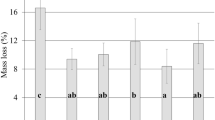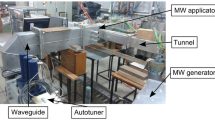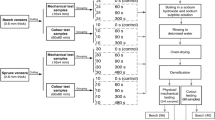Abstract
Some selected mechanical properties of spruce wood (Picea abies L.) were determined after freezing green timber boards under different conditions. The influence of the freezing rate and the time of exposure to negative temperatures were evaluated by applying three different freezing conditions which may occur in winter when green timber is stored in an open yard. It was found that a high freezing rate (−10 °C/h) does not affect wood strengths at all, while slow freezing (by −1 °C/h) significantly reduces all mechanical wood properties, especially MOR, MOE and the compressive strength (by 20…30 %), the Janka hardness (by 18 %), and also the tensile strength (by 10 %). A longer time of exposure, involving repeated freezing and thawing due to natural temperature variations led to further reduction of MOR, MOE and the compressive strength (up to 37 %), but without further affecting the tensile strength, shear strength and hardness. The obtained results may be useful to industrials with respect to a more careful planning of green timber purchase and storage in wintertime.
Zusammenfassung
Frisches Fichtenholz (Picea abies L.) wurde unter verschiedenen Bedingungen gefroren, um die Beeinträchtigung seiner mechanischen Eigenschaften zu untersuchen. Durch Untersuchungen bei drei Gefriersituationen wie sie im Winter bei der Lagerung von frischem Schnittholz im Freien auftreten können, wurden der Einfluss der Gefriergeschwindigkeit und der Dauer, bei der negative Temperaturen herrschen, untersucht. Die Studie ergab, dass bei hoher Gefriergeschwindigkeit (−10 °C/h), die mechanischen Eigenschaften des Holzes nicht beeinträchtigt werden, während beim langsamen Gefrieren (−1 °C/h) alle mechanischen Eigenschaften signifikant reduziert werden, vor allem die Biegefestigkeit, der Elastizitätsmodul und die Druckfestigkeit (um 20…30 %), die Janka Härte (um 18 %), aber auch die Zugfestigkeit (um 10 %). Eine längere Lagerung bei natürlichen Winterbedingungen mit wiederholten Gefrier- und Auftauperioden reduzierte die Biegefestigkeit, den Elastizitätsmodul und die Druckfestigkeit weiter (bis auf 37 %), während die Zugfestigkeit, die Scherfestigkeit und die Härte nicht weiter beeinträchtigt wurden. Die Ergebnisse können der Industrie für eine sorgfältigere Planung des Einkaufs und der Lagerung von frischem Schnittholz im Winter von Nutzen sein.





Similar content being viewed by others
References
Campean M, Ispas M, Porojan M (2008) Considerations on drying frozen spruce wood and effects upon its properties. Drying Technol 26:596–601
Cividini R (2001) Conventional kiln-drying of lumber. Nardi S.p.A
Delgado AE, Sun D-W (2001) Heat and mass transfer models for predicting freezing processes—a review. J Food Eng 47(2001):157–174
DIN 52 185 (1976) Prüfung von Holz. Bestimmung der Druckfestigkeit parallel zur Faser. Berlin
Erickson RW (1969) Effect of prefreezing upon hygroscopicity and shrinkage of thin cross sections of California rewood. Forest Prod J 19(5):55–56
Ilic J (1995) Advantages of pre-freezing for reducing shrinkage-related degrade in eucaliptus: general considerations and review of lieterature. Wood Sci Technol 29(4):277–285
ISO 3133 (1975a) Wood—Determination of ultimate strength in static bending
ISO 3346 (1975b) Wood—Determination of ultimate tensile stress perpendicular to grain
ISO 3349 (1975c) Wood—Determination of modulus of elasticity in static bending
ISO 3350 (1975d) Wood—Determination of static hardness
ISO 3347 (1976) Wood—Determination of ultimate shearing stress parallel to grain
Kärenlampi PP, Tynjälä P, Ström P (2005) Phase transformations of wood cell wall water. J Wood Sci 51:118–123
Kollmann F (1951) Technologie des Holzes und Holzwerkstoffe. Band I. Springer, Verlag
Kopstad G, Elgsaeter A (1982) Theoretical analysis of the ice crystal size distribution in frozen aqueous specimens. Biophys J 40(2):155–161
Kübler H (1962) Schwinden und Quellen des Holzes durch Kälte. Holz Roh-Werkst 20:365
Laurenzi W (2011) Experimental data processing. Part 2. Pro Ligno 7(1):51–59
Marinescu I (1980) Drying and heat treathment of wood. Volume II (in Romanian language). Technical Publishing House, Bucuresti
Mishiro A (1990) Effect of freezing treatments on the bending properties of wood. Bulletin of Tokyo University, Faculty of Agriculture, Department of Forest Products, Tokyo 82:177–189
Rahman MS (1999) Food preservation by freezing in Handbook of Food Preservation. In: Rahman MS (ed), Marcel Dekker, Inc. NY
Ramaswamy HS, Tung MA (1984) A review on predicting freezing times of foods. J Food Process Eng 7(3):169–203
Thunell B (1940) Svenska Skogsvarsdsfor. Tidskr 38:1
Vorreiter V (1938) Bending-strength and resistance to compression of frozen spruce timber. Thar. Forest. Jahrb 89–491
Wagenführ R (2000) Holzatlas. 5-te Auflage. Fachbuchverlag Leipzig
Wagenführ R, Scholz F (Hrsg.) (2007) Taschenbuch der Holztechnik. Fachbuchverlag Leipzig im Carl Hanser Verlag
Acknowledgments
This paper is supported by the Sectoral Operational Programme Human Resources Development (SOP HRD), financed from the European Social Fund and by the Romanian Government under the contract number POSDRU/88/1.5/S/59321.
Author information
Authors and Affiliations
Corresponding author
Rights and permissions
About this article
Cite this article
Szmutku, M.B., Campean, M. & Porojan, M. Strength reduction of spruce wood through slow freezing. Eur. J. Wood Prod. 71, 205–210 (2013). https://doi.org/10.1007/s00107-013-0667-6
Received:
Published:
Issue Date:
DOI: https://doi.org/10.1007/s00107-013-0667-6




